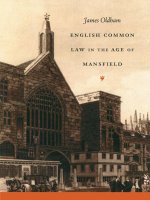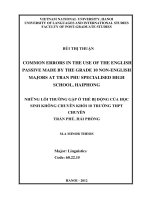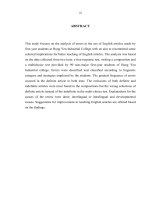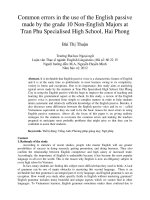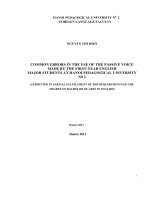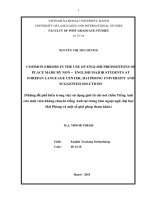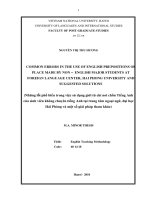English Common Law in the Age of Mansfield pot
Bạn đang xem bản rút gọn của tài liệu. Xem và tải ngay bản đầy đủ của tài liệu tại đây (3.63 MB, 445 trang )
English Common Law
in the Age of Mansfieldstudies in legal history
Published by the University of North Carolina Press
in association with the American Society for Legal History
Thomas A. Green, Hendrik Hartog, and
Daniel Ernst, editors
Lord Mansfield, painting by John Singleton Copley, 1783.
(Courtesy of the National Portrait Gallery, London)
English Common Law
in the Age of Mansfield
by james oldham
The University of North Carolina Press
Chapel Hill and London
©
2004 The University of North Carolina Press
Allrightsreserved
ManufacturedintheUnitedStatesofAmerica
Set in Janson
by Tseng Information Systems, Inc.
The paper in this book meets the guidelines for permanence
and durability of the Committee on Production Guidelines for
Book Longevity of the Council on Library Resources.
Library of Congress Cataloging-in-Publication Data
Oldham, James.
English common law in the age of Mansfield / by James Oldham.
p. cm. — (Studies in legal history)
Includes bibliographical references and index.
isbn0-8078-2869-6 (cloth : alk. paper) —
isbn0-8078-5532-4 (pbk. : alk. paper)
1. Law—England—History—18th century. 2. Mansfield, William Murray,
Earl of, 1705–1793 I. Title. II. Series.
kd612.o44 2004
340.5'7'094209033—dc22 2003025859
cloth 0807060504 54321
paper 0807060504 54321
Contents
Preface xi
Editorial Statement xv
Abbreviations xvii
part i
Mansfield and the Court of King’s Bench
1 Lord Mansfield 3
2 The Court of King’s Bench 12
part ii
Commerce and Contract
3 Contract and Quasi-Contract 79
4 Bankruptcy 107
5 Insurance 124
6 Negotiable Instruments 152
7 Usury 165
8 Prize and Trade 177
9 Intellectual Property 190
part iii
Crime and Tort
10 Libel 209
11 Restrictions on Religious Observance 236
[ vii ]
viii Contents
12 Nuisance 248
13 Assault, False Imprisonment, and Offenses
against Public Order and Welfare 260
14 Perjury 268
15 Negligence 276
16 Trespass and Trover 292
part iv
Status and Property
17 Slavery 305
18 Marriage 324
19 Labor and Employment 343
20 Property and Wills 356
Conclusion 364
Appendix: Table of Regnal Years 371
Bibliography 373
TableofStatutes 393
Table of Cases 395
General Index 409
Illustrations
‘‘Term Time, or, the Lawyers All Alive in Westminster Hall’’ 13
‘‘Councellor Double-Fee’’ 15
The Old Bailey 39
‘‘First Day of Term’’ 45
‘‘Lawyers in Term’’ 46
‘‘A Peep into Westminster Hall on a Call of Serjeants’’ 49
William Blackstone 109
‘‘A Meeting of Creditors’’ 114
King’s Bench Prison 123
‘‘Moderate Interest’’ 170
South front of Kenwood 203
John Wilkes 223
‘‘Sawny Wetherbeaten or Judas Iscariot’’ 223
‘‘The Royal Chace’’ 225
‘‘Inflammatory Arguments for and against the Test Laws’’ 238
‘‘View of the Public Office, Bow Street, with Sir John Fielding
Presiding’’ 264
‘‘He That Debaseth Himself Shall Be Exalted’’ 270
Granville Sharp 307
‘‘The Trial of the D. of Cumberland and Lady Grosvenor
for Crim. Con.’’ 338
[ix]
In 1992 the University of North Carolina Press, in association with the
American Society for Legal History, published my two-volume work en-
titled The Mansfield Manuscripts and the Growth of English Law in the Eigh-
teenth Century. The two volumes were made up of three parts: transcrip-
tions of notes taken by Lord Mansfield ofjury trials heconducted across his
thirty active years as Chief Justice of the Court of King’s Bench (1756–86),
my own explanatory essays, and a variety of appendixes. Together the two
volumes reached almost 1,700 printed pages. Because of its length and cost,
the work was aimed primarily at libraries and other institutional buyers;
certainly adoption for classroom use was not anticipated.
Most of the reviewers of the original work commented on the value of
the explanatory essays, noting, for example, that these ‘‘provide something
like a modern textbook of eighteenth-century law and legal history’’ and
that there exists no comparable source. These observations led naturally to
the idea of the present volume—a one-volume updated abridgment of the
explanatory essays that would be agreeable to most individual budgets and
feasible as well for classroom use.
Were it possibleto revisit England intheyear 1750, it probably would not
be evidentthatthe common lawcourtsover thenext half-century would lay
many of the foundation stones that would support the Anglo-American law
of the twenty-first century.Yet this proved true, both in commercial areas
(suchascontracts, insurance, negotiableinstruments, intellectual property,
and international trade) and in protecting the rights of individuals (as in
the law of negligence, nuisance, religious freedom, and slavery). Though
assisted by the work of able contemporary and predecessor judges, Lord
Mansfield was the dominant judicial force behind these developments.
The first two chapters of this book comprise a brief biographical sum-
mary of Mansfield and a fairly detailed description of the day-to-day busi-
ness and procedures of the common lawcourts (and to a lesser extent of the
Old Bailey), especially in the conduct of jury trials. Eighteen chapters then
follow that are devoted to specific substantive areas of law. The choice of
topics wasdictated bythenumber and nature ofthe proceedings over which
[xi]
xii Preface
Mansfield presided, in particular the jury trials. I have tried to preserve for
each subject a treatment that will be informative and satisfying without re-
quiring the reader to resort to other sources for basic understanding. Two
chapters—trespass and trover, and property and wills—are radically short,
which I explain as due to the lack of substantial changes in the common
law of these subjects during the Mansfield years. Other chapters that could
seem disproportionately large are justified by the importance to modern
law of the subject matter and by the defining Mansfield imprint.
None of the transcriptions of trial notes contained in the original two-
volumework is reproduced here, although manyof those cases arediscussed
and cited. I have, however, included numerous references to and descrip-
tions of relevant books and articles that have appeared in the past decade.
Also, I have included references to additional documentary sources that I
have examined since 1992, mainly sources held by the libraries of three of
the Inns of Court in London—Lincoln’s Inn, the Middle Temple, and the
Inner Temple.
I am grateful to the many colleagues who encouraged the idea of this
book and whowrote to thePress lending their support. In particular I thank
John Baker, John Beattie, Henry Bourguignon, Robert Gordon, Stanley
Katz, John Langbein, Kent Newmyer, John Orth, and Brian Simpson.
Overseeing the project with unerring judgment and sound advice was Tom
Green, who continues his longstanding, extraordinarily constructive ser-
vice as coeditor of the Studies in Legal History series.
In the years intervening since the publication in 1992 of the original
two-volume work, additional documentary research in London has been
made possible by sabbatical funding and summer research grants from the
Georgetown University Law Center. Also, when the press indicated that it
hoped forasubventionfor thiswork, theLawCenter’sDean, Judith Areen,
immediately supplied the necessary funds. Dean Areen has been a steadfast
supporter of scholarly work, and I am in her debt.
In the task of abridging the essaychapters and conforming to the guide-
lines followed by the Press, I have had indispensable help from Faculty As-
sistant Diane Hedgecock,Faculty Manuscript Editor Anna Selden, and Re-
search Assistants Avedis Seferian, Cynthia Fleming, and Ibie Adeyeye. For
library and bibliographical queries, Special Collections Librarian Laura
Bédard, as always, has provided invaluable help, ably assisted by Special
Collections Assistant Erin Kidwell.
At the University of North Carolina Press, I thank Chuck Grench and
Amanda McMillan fortheirresponsible managementofthis unique abridg-
Preface xiii
ment and for pacifying me when I grew impatient. I was fortunate also in
that the final preproduction phase, copyediting, was handled by Assistant
Managing Editor Paula Wald and copyeditor Julie Bush. Paula copyedited
the original two-volume manuscript, and in the present work, Julie was her
capable successor.
Finally, my thanks to indexer Barbara Wilcie Kern. Without a careful
index, the effectiveness of a work of legal history is much diminished. As in
the original two-volume work, Barbara has given users of this volume easy
access by her meticulous, detailed index entries.
The following editorial principles and decisions were applied in preparing
this work:
1. During the late eighteenth century, some subject areas were develop-
ing or changing more rapidly than others. For this reason, there is greater
emphasis in this book on commercial topics such as insurance and contract
than on subjectssuchas realpropertyandwills.Alsoemphasized aresubject
areas of particular interest to the modern reader such as slavery, religious
toleration, seditious libel, collective action by workers, married women’s
property rights, breach of warranty (a subdivision of contract), negligence,
and nuisance.
2. Throughout this work, I follow guidelines in The Chicago Manual of
Style for the citation of primary and secondary sources. Some invention
was necessary, however, for citing the cases in Mansfield’s trial notes. In
the form that I use—for example, ‘‘449 nb 35’’—the first number signifies
the volume and the last number the page within a given notebook. Volume
numbers for the notebooks were assigned by the National Register of Ar-
chives (Scotland). The first volume number assigned was 449.
3. For printed cases, I follow the usual conventions for citation to the
Englishnominative reports, as reflected in thefull reprint of the English Re-
ports.InthefootnotesIciteonlythereportsofcasesinthenominativere-
ports, and usually only to the best-known versions for cases that have mul-
tiple reports in the nominatives. One exception is in chapter 17, where all
known reports of important slave cases are of interest and are cited. Also, in
the Table of Cases, I give page and volume cross-references to the English
Reports forallcasescitedinthebookthatappearintheEnglish Reports.
4. For English statutes through 1713, I use Statutes of the Realm,12vols.
(London: G. Eyere and A. Strahan, 1810–22; reprint, London: Dawson of
Pall Mall, 1963). According to Sir William Holdsworth, this edition is ‘‘the
only one that can be relied upon for historical purposes,’’ although Percy
Winfield observed, ‘‘That it might have been much better than it actually
was, without making impossible demands on the editors, is an unfortunate
fact’’ (W. S. Holdsworth, Sources and Literature of English Law [Oxford:
[xv]
xvi Editorial Statement
Clarendon, 1925], 58; P. H.Winfield, The Chief Sources of English Legal His-
tory [Cambridge: Harvard University Press, 1925], 92). Using Statutes of the
Realm creates some difficulty, because there are occasional variances be-
tween the regnal years and chapter numbers given and those used in the
printedstatute compilations incirculation intheeighteenth century.When
this occurs in statutory citations in this work, the location of a cited statute
in the common printed editions is given in brackets after the citation to
Statutes of the Realm.
Statutes of the Realm was prepared pursuant to a parliamentary commis-
sion but covers statutes only to the end of the reign of Queen Anne. The
elephant folio 1963 reprint should be available in most law libraries. For
the remainder of the eighteenth century after Queen Anne, I cite O. Ruff-
head, ed., TheStatutesatLarge,FromMagnaChartatothe 39thYearofthe
Reign of King George the Third, Inclusive, 18 vols. (London: M. Baskett et al.,
1763–99). Thereafter, I use D. Pickering and G. K. Richards, eds., Statutes
at Large from Magna Charta to the End of the Eleventh Parliament of Great
Britain, Anno 1761–1869, 109 vols. (Cambridge: Printed by J. Bentham for
C. Bathurst, 1762–1869).
5. Two major sources cited throughout this work are William Black-
stone’s Commentaries on the Law of England and William Holdsworth’s His-
tory of English Law.IcitethefirsteditionoftheCommentaries, except in
chapter 17, in which Edward Christian’s commentary to the thirteenth edi-
tion is quoted. Because Holdsworth’s History of English Law was published
over a span of sixty-three years, for the sake of consistency, citations refer
to Methuen, Sweet and Maxwell’s 1966 reprint.
6. For the illustrations in this work, I supply narrative captions to enable
the reader to understand the relevance of the illustration and its content.
Some of the satirical caricatures reproduced would be mysterious without
explanation, but this is easily remedied for the caricatures that are in the
Dorothy George collection at the British Museum Department of Prints
and Drawings. This collection is indexed in Dr. Mary Dorothy George’s
Catalogue of Political and Personal Satires. George’s phenomenal descrip-
tive narrative explains virtually every known character, characteristic, and
nuance of the caricatures in the collection. Those illustrations with cap-
tions that cite a ‘‘DG’’ number come from the Dorothy George collection,
and the captions for those illustrations paraphrase the descriptive material
in the Catalogue.
7. Where necessary for comprehension or clarity, I have modernized
spelling, capitalization, and punctuation in quotations from case reports
and documentary sources.
Abbreviations
The following abbreviations are used throughout. Standard law reports
cited in this work are abbreviated as in the English Reports and therefore are
notincludedinthislist.
Add. MSS Additional Manuscripts, Manuscript Division, British
Library, London.
APB Ashurst Paper Books, Dampier Manuscripts, Lincoln’s Inn
Library, London.
BPB Buller Paper Books, Dampier Manuscripts, Lincoln’s Inn
Library, London.
Cald. Caldecott’s Reports, or, T. Caldecott, ReportsofCasesRelativeto
the Duty and Office of a Justice of the Peace From Michaelmas
Term 1776, Inclusive to Trinity Term 1785, Inclusive (London:
ForP.Uriel,1786–97).
CRO Corporation of London Records Office.
DG M. D. George, Catalogue of Prints and Drawings in the British
Museum, ed. F. G. Stephens, vols. 1–4 (in 5 vols.); Catalogue
of Political and Personal Satires Preserved in the Department of
Prints and Drawings in the British Museum,vols.5–11
(London: British Museum, [1870]–1954).
MMSS I James Oldham, The Mansfield Manuscripts and the Growth of
English Law in the Eighteenth Century, vol. 1 (Chapel Hill:
University of North Carolina Press, 1992).
MMSS II James Oldham, The Mansfield Manuscripts and the Growth of
English Law in the Eighteenth Century, vol. 2 (Chapel Hill:
University of North Carolina Press, 1992).
OED The Compact Edition of the Oxford English Dictionary,2vols.
(Oxford: Oxford University Press, 1971).
PRO Public Record Office, London.
ASSI Assize records.
KB King’s Bench records.
[xvii]
xviii Abbreviations
SP State Papers.
TS Treasury Solicitor’s Papers.
S.T. State Trials,orT.B.Howell,ed.,Cobbett’s Complete Collection
of State Trials and Proceedings for High Treason,33vols.
(London: R. Bagshaw and other publishers, 1809–26).
part one
Mansfield
and
the Court
of King’s Bench
Lord Mansfield
A
t the outset of this study of English common law at the time and in the
light of Mansfield, an introduction should be given to the man and
to the court over which he presided, through which he reshaped
the law. Some familiarity with Mansfield’s attributes, and with the stature
and procedures of the Court of King’s Bench, will also be helpful in under-
standing the developments in the various subject areas that are the main
body of this work.
Known to his family as Will, Mansfield was born William Murray on
2 March 1705
1
in Perth, Scotland, at the hereditary home, Scone Palace.
There were fourteen siblings, six brothers and eight sisters, but William
alone emerged as a prominent and influential public officer in England and
became very rich. Both of these stations he reached by indefatigable effort
and genuine ability. His early years at the bar probably were boosted by
Scottish patronage, and he appears to haveenjoyed fortuitous financial help
while at Oxford,
2
butbyandlargehemadehisownway.
William traveled by horseback from Scotland to London at age four-
teen, where he enrolled at Westminster School. He excelled, becoming a
prize-winning King’s Scholar. From there he progressed to Christ Church,
Oxford, where he threw himself into classical studies, translating Cicero’s
Latin orations into English and back again.
Murray’s attachment to the law began early. He was entered in Lincoln’s
Inn in April 1724 while still an undergraduate at Oxford.
3
After receiving
. All dates are converted to thenew-style (Gregorian) calendar,which took effect in 1752.
SeeC.R.Cheney,ed.,Handbook of Dates for Students of English History (London: Royal His-
torical Society, 1978), 1–11.
. See J. Campbell, The Livesof the Chief Justices ofEngland, 3vols. (London: John Murray,
1849–57), 2:336–39; E. Heward, Lord Mansfield (Chichester and London: Barry Rose, 1979),
16–21.
. Campbell, Chief Justices, 2:178.
[3]
4 Lord Mansfield
hisB.A.in1727,hetookupstudiesatLincoln’sInnuntilcalledtothebar
in November 1730.
4
Reading law at Lincoln’s Inn was, by the 1720s, largely
self-study.The only formal requirements were ‘‘to dine in the hall five days
each term’’ and ‘‘to read the first sentence of a paper prepared for him by
thesteward,’’a meaninglessformal exercise conducted onceaterm.
5
Never-
theless, Murray took his time at Oxford and at Lincoln’s Inn seriously, ex-
hibiting two characteristics that served him all his life: a readiness to per-
form the long hours of drudgery and apprenticeship necessary to develop a
thorough grounding in a subject or a skill, and an irrepressible intellectual
curiosity. Lord Campbell says that while at Oxford, ‘‘he had attended lec-
tures on the Pandects of Justinian, which gave him a permanent taste for
that noble system of jurisprudence.’’
6
Letters he wrote at different stages of
his life on the study of ancient and modern history
7
reveal his deep famil-
iarity with classical works.
8
He also studied oratory, even, while a student
atLincoln’sInn,practicingthearttothepointofspeakinginfrontofa
mirror while being coached by his friend Alexander Pope.
9
Still later, but
while a newcomer to the bench, Mansfield wrote to his brother judge, John
Eardley Wilmot, about Taylor v. Horde,
10
observing, ‘‘While the Company
is at cards I ply my Rubbers at this Work, not the pleasantest in the World
butwhatmustbedone,Ilovetodo,&haveitover.’’
11
Murray was called to the bar 23 November 1730, after spending the long
vacation on the Continent.
12
Very shortly he established himself in cham-
. Murray was also awarded an M.A. from Oxford in June 1730.
. Campbell, Chief Justices, 2:327.
. Ibid.
. J. Holliday,The Life of William Late Earl of Mansfield (London: ForP.Elmsly, D. Brem-
ner,T. Cadell, Jr.,W. Davies, et al., 1797), 12–23, reprinting letters published in the European
Magazine, and London Review, 1792, fols. 182 and 257.
. J. Buchan wrote: ‘‘We do not suppose Mansfield to have been a classical scholar of the
stampofCarteret,buthehadtherespectablestockintradeofanindustriousOxfordman;
and we are told that once, in his extreme old age, he defended the use of a Greek word in
Burke by quoting offhand a long passage from Demosthenes. In history, on the other hand,
and especially in the history of law, few of his contemporaries approached him. Burke had
the samesynoptic view,the same Catholic breadth of knowledge,but Mansfield had the more
exact andcritical scholarship’’ (Some Eighteenth-Century Byways and Other Essays [Edinburgh:
W. Blackwood and Sons, 1908], 87).
. Campbell, Chief Justices, 2:330; Holliday, Mansfield, 24–25.
. 1 Burr. 60 (1757).
. Add. MSS. 9828, fol. 33, letter, 29 Dec. 1757.
. Holliday, Mansfield, 11. Only three times in Murray’s long life is he known to have
ventured out of the country—first, while a student at Oxford, to visit his brother James in
Paris; second, the trip before admittance to the bar; and third, to France in 1775.
Lord Mansfield 5
bers at No. 5 King’s Bench Walk in the Inner Temple. How he prospered
duringhisearlytimeatthebarisnotfullyknown,butbyhisownaccount,
after his success in December1737asjunior counsel for William Sloper, ac-
cusedcorrespondent inacriminal conversation casebroughtby Theophilus
Cibber,‘‘businesspouredinuponmeonallsides.’’
13
During his first eight
years of practice, his earliest business of consequence appears to have come
from Scottish sources,suchashis appearances asjuniorcounselinanumber
of Scottish appeals in the House of Lords in 1733 and 1734.
14
Other cases that sustained Murray during this period were colonial dis-
putes heard beforetheCommissionersforTradeandPlantations (theBoard
of Trade).The journal of the Board ofTrade revealsappearances by Murray
in the prolonged dispute from 1734 to 1737 between the Penns and Lord
Baltimore over the boundaries of Maryland,
15
and in 1734–35 as counsel
for the agent of New Hampshire in a boundary dispute with Massachusetts
Bay.
16
He represented the trustees of a Georgia company in a 1736 dispute
with South Carolina over laws regulating the India trade,
17
and in 1737–38,
he acted for a Rhode Island agent in a boundary dispute with Massachu-
setts Bay.
18
Also during the 1730s, Murrayappeared frequently before the Bar of the
House of Commons and its committees. Eclipsing in importance any pre-
vious activity, however, was the affair of Captain Porteous. Riots in Edin-
burgh had resulted in the vigilante-style lynching of Porteous, a Captain
of the Guard who had ordered his men to fire on an unruly crowd attend-
ing an execution in 1736.
19
Several in the crowd were killed; Porteous was
tried and sentenced to death but was afterward reprieved by Queen Caro-
line. The reprieve engendered the riots, and in London in April 1737, a re-
tributory bill was introduced in Parliament to put the city of Edinburgh
under certain disabilities. Murray acted as counsel for the Lord Provost of
Edinburgh. Ultimately, the city was given only nominal punishment, and
Murray’s role as counsel was widely praised.
In light of the foregoing, it is clear that Murray’s characterization of the
. Holliday, Life of Mansfield, 36.
. Campbell, Chief Justices, 2:259–60.
. Murray was counsel for the Penns.
. Journal of the Commissioners for Trade and Plantations 4 (Jan. 1728–29 to Dec. 1734):
429; 5 (1734–35 to 1741): 11, 17.
. J. P. Egmont, ManuscriptsoftheEarlofEgmont:DiaryofViscountPercivalAfterwards
FirstEarlofEgmont, Historical Manuscripts Commission, 3 vols. (London: HMSO, 1920–
23), 2:320 (letter, 17 Dec. 1736).
. Journal of the Commissioners for Trade and Plantations 5 (1734–35 to 1741): 236–37, 239.
. The story is told by Sir Walter Scott in his novel, The Heart of Midlothian.
6 Lord Mansfield
Theophilus Cibber case as a turning point was overstated. Campbell was
correct in observing that Murray’s reputation was well established by then,
and a variety of business was steadily coming his way. Murray does not ap-
pear to have had a moment of self-doubt; by 1738 his career was strongly
launched.
On 20September1738, Murrayand Elizabeth Finchweremarried.Eliza-
beth’s grandfather (who died before she was born) was Heneage Finch,
first Earl of Nottingham, the great seventeenth-century Lord Chancel-
lor.
20
Like Murray, Heneage Finch was educated at Westminster School
and Christ Church, Oxford. Granddaughter Elizabeth was an intelligent,
sociable woman from a distinguished family who shared with Murray an
evidently happy,childlessmarriageofforty-sixyears until herdeath in1784.
From about the time of his marriage, Murray began to enjoy an in-
creasingflowofbusinessintheCourtofChancery.AsrevealedinAtkyns’s
Reports,
21
Murray appeared in dozens of cases before Lord Hardwicke.
Murray’s later inclination to reach for equitablenotions in hisKing’s Bench
decisions
22
has been linked to this practice and to his strong admiration for
Hardwicke.
23
Possessed of widely recognized talent, Murray was positioned to be
drawn in by the tentacles of patronage of the Duke of Newcastle. When
this happened, the ambitious Murraydid not resist. In 1742, Newcastle con-
trived Sir John Strange’s resignation as Solicitor General in order to make
room for Murray; Murray was appointed and at the same time took his seat
in the House of Commons representing one of Newcastle’s many pocket
boroughs, Boroughbridge. As Solicitor General, he became allied, as a law
officer for the Crown, with Attorney General Dudley Ryder. Ryder had
been Attorney General since 1737 and would continue until 1754 when he
became Chief Justice of the Court of King’s Bench, elevating Murray to
Attorney General. BecauseRyderwasacopious shorthand diarist and note-
. See generally D. E. C.Yale, ed., Lord Nottingham’s Chancery Cases, 2 vols. Publications
of the Selden Society, vols. 73, 79 (London: B. Quaritch, 1957–61), 1:ix–xxxvi.
. Also in West, temp. Hardwicke.
. This tendency was one point of attack in the Junius letters directed at Mansfield. See
chapter 2, text at n. 61. Campbell denied that Mansfield did anything improper in this way.
Campbell, Chief Justices, 2:317.
. After Hardwicke’sretirement from the bench, Mansfield borrowed from him amanu-
script copyof oneof Hardwicke’s decisions, andinhis letterreturningthe manuscript, Mans-
field wrote that Hardwicke’s reasoning ‘‘put the general Law of Property uponsoconsis-
tent a Foundation, free from ev’ry Mischief which sprung from the Narrow Plan applied to
Uses, that I have ever since formed from it a System to Myself’’ (Add. MSS. 35,595, fol. 312,
letter, 10 Dec. 1758).
